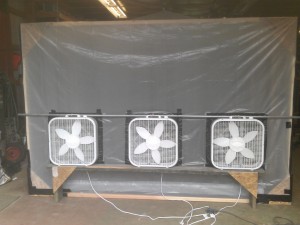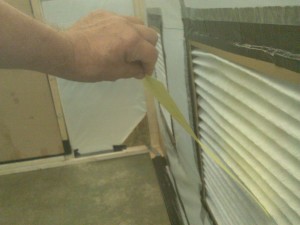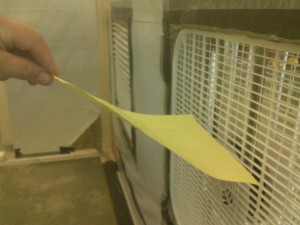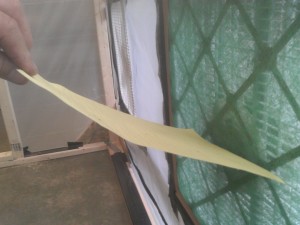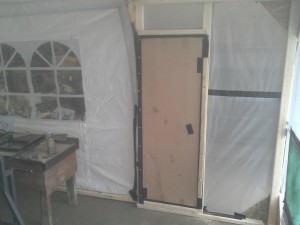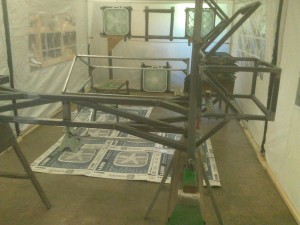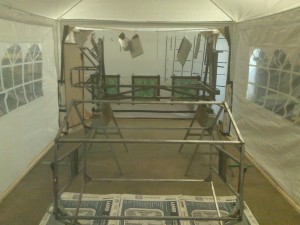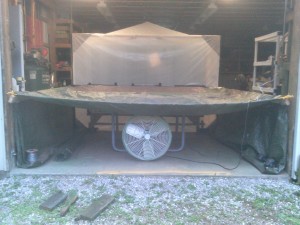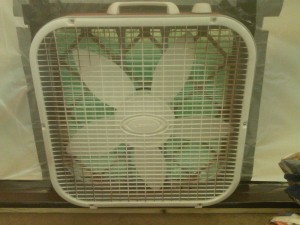Air Flow
First I did some calculations. A pro, cross-flow paint booth is supposed to move air at a velocity of 100 feet/minute (FPM). With the average 75 square feet of cross sectional area of my booth (width x height), 100 feet of air yields a volume of 7,500 cu ft, so I need to move 7,500 CFM. I bought these box fans at the big orange box for about $17 each, and each can move 2,500 CFM. A little optimistic I know, but I figure it’s good enough. I installed 3 on the exhaust wall with a standard 20×20 pleated filter on the inlet side of each fan. I installed 3 more filters on the inlet wall.I closed my cardboard door and ran a test. You can see the effects of the negative pressure on the tent walls but the airflow didn’t feel right. I did a simple test with a sheet of paper, first with the door closed and filters in place. Then, I tested with the door open and filter removed to see what I could get at maximum flow. Quite a lot more!
Back to the big orange box to get some EZ-Flow fiberglass filters, cheap at 4 for $2.67, and I bought 3 more fans for the inlet wall so I could run at neutral pressure so the walls would hang straight. I know the pleated filters are much better but you just can’t push air through them with cheap box fans. You can see in my final test that airflow was close to max, helped along by the additional inlet fans.
Cardboard Access Doors
I needed a cheap but airtight access door so I grabbed the largest scrap cardboard I could find and framed a door to fit (24″ wide). I duct-taped around the edges to harden the edges a little, and I used a length of furring strip and 2 eyelet screws to latch the opening side closed and airtight. Works great. For hose access, I framed a little 9×9 opening. After running hoses through, I stuff the opening with rags to seal it. Also works great except that my pressure adjustments are outside the booth. I’ll fix that later by running full pressure into the booth and mounting regulators in the booth.Painting and Some Other Issues Resolved
Here’s the final setup with tumbler parts in place, ready for painting. The lighting is barely adequate for this job so I will be adding lighting before doing any painting on the MC850. However, the diffused light coming through the party tent does a nice job of eliminating shadows. It’s just not enough even with very good lighting in the barn. Here, because the booth is 8 ft from the barn door, I cobbled up an exhaust tunnel/duct with a large tarp. The fan is a high-power, high-velocity fan like we use to cool our alpacas. It will blast any exhaust at least 20 ft from the barn before it slows down. This worked well, and the barn was odor free when I finished painting. One problem I encountered was some reverse air flow in the booth. The cause was apparent after painting for awhile. You can see paint around the perimeter of the inlet fan grills. I cut some cardboard baffles to cover the paint-coated areas and installed them on all 6 fans. The result was inproved airflow, and the reverse flow seemed to have been eliminated.Overall, a very good first test.
You might be wondering how I’ll get the tumbler out and the MC850 back in. I wish the booth had a door but it doesn’t. I plan on un-taping the 4 ft extension and sliding it to the side. Not very convenient, but it will get the job done. The bench supporting the front fans will be a bit of a problem. I think I’ll just build the fan support into the extension.
My next post will be strictly MC850 work. I promise.



